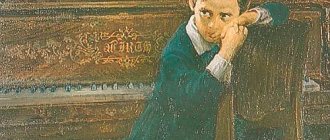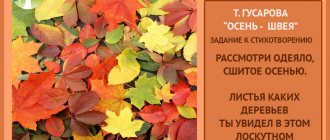What are folk traditions and customs?
Many families have their own traditions and customs. In one, for example, they always drink tea with lemon in the morning, and hot cocoa in the evening. And so every day. Another family may have different customs. For example, give each other handmade cards for the holidays.
Traditions and customs are characteristic not only of individual families, but also of entire nations. Some of them may seem stupid and funny, others - understandable and wise. The Slavic peoples have a very good tradition of giving up their seats in transport to the elderly. This seems normal to all of us. But the French do not do this.
Russian folk traditions in kindergarten
This work participates in the regional publication competition “Kindergarten: day by day.” The author's spelling and punctuation have been preserved!
Times are different now, as are thoughts and deeds -
Russia has gone far from the country it was.
Our people are smart, strong, looking far ahead,
But we must not forget the traditions of antiquity!
N. Konchalovskaya “Our ancient capital.”
Today, the leading principle of education should be considered education carried out on the roots of national culture. There is a lot of talk about the revival of the Fatherland. Reviving the culture of our people and traditions is a difficult and noble task. Preschool age is a favorable period for introducing children to the origins of folk culture, which can revive the continuity of generations, convey moral principles, spiritual and artistic values.
Each nation has its own traditions that are passed on from generation to generation. The Russian land has always been famous for the beauty and richness of music, literature, its holidays and customs. It is the native culture that must find its way to the child’s heart and form the basis of his personality.
The work of teachers and the music director is aimed at developing in preschool children general ideas about the culture of the Russian people. Specialists and preschool teachers gradually lead children to understand the harmonious connection between man and the surrounding nature, including them in interesting activities. Nursery rhymes, sayings, proverbs, games, songs, folk instruments, dances - all these types of children's activities create an opportunity for the child to come into contact with the historical past. The national holiday helps children learn to express themselves creatively and communicate freely with their peers.
In the MADO "Sibiryachok" building No. 3, holidays and thematic classes dedicated to folk traditions have been held for several years now. Children take part in such events with great pleasure. Folk holidays and entertainment include all forms of children's creativity.
Recently, for older preschoolers at the Sibiryachok Children's Preschool Educational Institution, building No. 3, a holiday “On a visit to Zimushka-winter” was held in Russian traditions. The purpose of this event was to introduce children to ancient Russian customs and traditions. The hosts of the holiday, the Buffoons, warmly received the guests. Together with the children, they went to the fairy forest to visit Zimushka - winter. Along the way, the guys played various games and competed in relay races. The games and fun of Zimushki - winter also delighted the children.
In our kindergarten, children live in a cozy world of warmth and kindness, in a world of spirituality and fantasy. After all, all the best that begins to form in kindergarten will be reflected in later life and will have an exceptional impact on the subsequent development and spiritual and moral achievements of a person.
Author: Glebova Tatyana Aleksandrovna, music director
MADO AR kindergarten "Sibiryachok".
“Certificate of publication in the media” Series A No. 0007371.
From the editors of the online publication “Kindergartens of the Tyumen Region” All authors of reports in the “Preschool News” section, which are published under an editorial agreement with a preschool educational institution, can order a “Certificate of publication in the media” at any time. Sample: Certificate of publication in the media.pdf
Go to order form >>>
Dear Colleagues! Tell us about interesting events in your kindergartens. How to become an author >>>
Your material will participate in the regional competition “Kindergarten: Day by Day” for the best coverage of the activities of a preschool educational organization in the Internet space in the 2021/2022 academic year. Awarding on the Day of teachers and preschool education workers at the regional holiday Pedagogical Forum in the Department of Education and Science.
Share
Traditions of the peoples of the world for children
About 3 thousand different peoples and nationalities live on our planet. Each nation has its own special traditions. Some of them are very unusual for us Russians.
- When we say “yes,” we are used to nodding our heads. But the Bulgarians and Albanians do the opposite. To confirm what has been said, they wave their heads from side to side. A nod means "no."
- In Russia, the number 13 is considered unlucky, especially if it falls on a Friday. Such a day is jokingly called “the day of evil spirits.” In Spain, troubles await not on Friday, but on Tuesday the thirteenth. In some countries, six is considered an unkind number. In China it's a four. Some houses there don't even have a fourth floor. After the third comes the fifth.
- Men in Russia greet by shaking hands. And this is also an ancient custom. This is how our ancestors showed each other that they did not have weapons or stones in their hands. Handshakes are not accepted in Japan. They are replaced by bows. In India, as a sign of greeting, the palms are raised to the chin, as if for prayer, and, shaking the head, they say “namaste”. Eskimos rub noses when they meet. Because of the cold, only their faces are exposed.
Traditions and customs related to children
There are many traditions associated with the birth and raising of children:
- Turkmen girls aged 9-10 undergo the ceremony of braiding their hair. They undo two braids and make 20 small braids. From this day on they are considered adults. The outfit also changes.
- The Kazakhs have a custom of “cutting fetters.” When the baby takes his first steps, his legs are tied with a cord. A respectable man with many children is entrusted to cut it. The ceremony is accompanied by songs and wishes to stand firmly on your feet and walk confidently through life.
- Indians throw their newborn children from a 15-meter tower. They fall onto the tent stretched below. People believe that after this the children become lucky.
Eating
It is common for us to have breakfast and lunch while sitting at the table, and take food from a plate with a spoon and fork. But not everyone eats this way.
- The Chinese and some other eastern peoples use chopsticks instead of spoons and forks.
- Asians also eat while sitting on the floor or on low cushions.
- In India they eat with their hands. More precisely, with one hand - the right.
National dishes
Different nations have their own favorite food.
- Indian cuisine is distinguished by an abundance of different spices. Their dishes are very spicy. Indians prefer cereals, vegetables and fruits to meat.
- The Japanese eat mostly raw food. The basis of national Japanese cuisine is rice and sea creatures (shrimp, fish).
- The peoples of the Far North mainly eat meat. They hunt deer, seals, and walruses. Roots, berries and plant stems are also collected here.
- Italian cuisine is called one of the best in the world. Italians prepare delicious pasta - pasta and dumplings, which they call ravioli. This is also the birthplace of pizza.
Cloth
National clothing also belongs to the traditions of peoples.
- Women of the Middle East wear a strange attire for us - a dark and long burqa. Only the eyes remain open. It is not customary here for anyone to see even a part of a woman’s body.
- Indian women wear saris, long, colorful pieces of fabric intricately tied around the body. Putting on and wearing a sari is considered a real art.
- The Japanese national dress is kimono. It is very similar to a bright silk robe with a wide belt (obi). Kimono comes in women's, men's and children's sizes.
- Scottish men wear a kilt. This is a skirt. And part of the national costume of the Scots is a musical instrument - the bagpipe.
- Eskimos living in the Far North wear a kukhlyanka and high boots to keep warm from the severe cold. Special clothing is made from animal skins and fur.
- The national clothing of Greek men is also a skirt. It must be white, with 400 folds. On top is a snow-white shirt with puffy sleeves, a bright vest and a belt. Women dress up in a multi-layered suit with an apron, decorated with ringing coins.
Introducing preschoolers to the traditions and way of life of the Russian people through various genres
Dear friends, we are pleased to introduce you to Galina Nikolaevna Korobova, music director of the first qualification category of the MBDOU TsRRDS “Gnezdyshko” in Chernogorsk, Republic of Khakassia. Today Galina Nikolaevna is happy to share with us her professional experience in introducing preschoolers to the traditions and way of life of the Russian people through various genres. The article will be of interest to teachers and interested parents.
A short commentary on the article from Galina Nikolaevna:
“Russian folklore is a type of art that can help achieve the goal: to ignite a spark of love and interest in children in the life of the people, their history and culture, and give them the opportunity to feel like an individual.”
Fascinating reading...
Introducing preschoolers to the traditions and way of life of the Russian people through various genres
No one can become a son
of his people, if he is not imbued with those
basic feelings
how the people's soul lives.
V.V. Zenkovsky
How we see our future depends on us and on the principles that we instill in the minds of children.
In the Decree of the President of the Russian Federation of June 1, 2012 No. 761 “On the National Strategy of Action in the Interests of Children for 2012-2017.” One of the main tasks is “the formation of a new public-state system of raising children, ensuring a high level of citizenship and patriotism”... Without knowledge of the traditions of one’s homeland, the cultural heritage of one’s people, the implementation of such a task is impossible.
Native culture is the truth and beauty that fills human hearts.
Our teachers face the following challenges:
- develop children's understanding of cultural heritage;
- to cultivate respect for the native land and pride in it;
- teach to be careful and treat everything that surrounds us.
Spiritual creative patriotism must be instilled from early childhood. But like any other feeling, patriotism is acquired independently and experienced individually. It is directly related to a person’s personal spirituality, its depth. Therefore, without being a patriot, the teacher himself will not be able to awaken in the child a feeling of love for the Motherland. It is to awaken, and not to impose, since the basis of patriotism is spiritual self-determination.
Formation of spiritual and moral attitudes and a sense of belonging to the cultural heritage, understanding of one’s national characteristics, formation of self-esteem as a representative of one’s people. And this is where the example of adults and especially loved ones is so important.
Today we are beginning to look at many things in a new way, we are rediscovering and re-evaluating many things for ourselves. This also applies to the past of our people.
“The Russian people should not lose their moral authority among other peoples. We must not forget about our cultural past. That is why the native culture, like father and mother, should become an integral part of the child’s soul, the beginning that gives rise to personality” (D.S. Likhachev.)
Folklore is the richest source of cognitive and moral development of children. Enriches his spiritual world, develops patriotism, respect for the past of his people, and the study of its traditions.
Russian folklore is a type of art that can help achieve the goal: to ignite a spark of love and interest in children in the life of the people, their history and culture, and give them the opportunity to feel like an individual.
Work in this area has been carried out in our garden for many years. All teachers are tasked with shaping the spiritual world of man of the third millennium, reviving and flourishing the cultural traditions of the peoples of Russia. Folklore classes help solve this task of personality development. For deeper knowledge, I turned to educational technologies:
O.A. Knyazev “Introducing children to the origins of Russian folk culture”
T.A. Budarin "Introducing children to Russian folk art."
Having analyzed the contents of these publications, I came to the conclusion that Russian folklore is an understandable and accessible area of creativity.
In music classes to familiarize ourselves with the surrounding life and traditions, I use thematically selected Russian folk games, such as: “Mill”, “Churilki”, “Golden Gate”, “Masha put on a mitten” and others.
Nursery rhymes, chants that reveal the characteristics of certain objects or phenomena: “Fall, white snow falls!”, “Rain, pour rain”; "Hey! Our cheerful people!” and others.
Through repeated repetition of the text of games and round dances, children quickly remember unfamiliar words, which allows them to develop their memory, including musical memory.
When selecting folklore material, I take into account the age capabilities of children.
Starting from the younger group, I introduce children to lullabies that can add variety to any type of activity: Bayu-bayu, bainki...”, “Kach, kach, kach...”, “Lyuli, lyuli, lyulinki”...
In older preschool age, I pay attention to introducing children to round dances, which are different in type, character and tempo of performance, with interesting choreographic patterns. They, like no other genre of adult folklore, are most suitable for children. These are such as: “I am sitting on a pebble”..., “Vesya, cabbage”, “There is a path in a damp forest”, “I am walking with a loach” and others.
In my practice, I widely use round dance songs, ditties, and game song choruses, which allows children to sing freely and uninhibitedly.
The children's acquired knowledge about traditions, customs, and rituals is used in conducting ritual holidays. Roles for children are assigned according to their age and creativity.
In our kindergarten, such folk, calendar holidays are held as the Fair, Autumn, Cabbage Festival, Carols, Maslenitsa, which have their own goals and objectives - this is the creation of a joyful mood and positive emotional attitude in the child, the formation of moral qualities and artistic taste. Mastering moral standards, uniting adults and children.
Getting acquainted with the traditions and way of life of the Russian people, children with great pleasure sing Russian folk songs, tell nursery rhymes, teases, dance in round dances, play Russian folk musical instruments, and at the same time feel relaxed, imitating adults, leaving positive impressions in their souls for a long time.
I would like to believe that the knowledge and skills acquired by children in preschool age will help our students become true patriots of the Motherland and will be beneficial in later life, rewarding them with love and respect from the people around them.
Holidays in different countries
There are holidays that are celebrated all over the world - New Year, birthday, wedding. And there are absolutely special ones.
- In Japan, one of the main holidays is Hinamatsuri, the “festival of dolls.” Every year on March 3, girls in elegant kimonos lower boats with paper dolls down the river. People believe that dolls take away sorrows and misfortunes with them.
- India has its own holiday - the “monkey feast”. The monkeys are served a table full of goodies. This is how Hindus worship the god Rama and his monkey army. The arrival of spring is celebrated here with a festival of colors, during which people douse each other with water painted in bright colors.
- Scotland hosts a very spectacular fire festival. In the evening, people dress in national costumes and carry burning torches to traditional music.
New Year
Celebrating the New Year is one of the most long-awaited customs for children. On the night from December 31 to January 1, it is celebrated in almost every home. Briefly about New Year's traditions of different nations:
- In Russia, gifts are given to children by the kind Grandfather Frost in a long fur coat with a magic staff in his hand. He has a granddaughter, Snegurochka, and a wife, Zima. He lives in Veliky Ustyug.
- In Poland, instead of Father Frost, children are congratulated by Saint Nicholas. He rides a horse and wears a white robe. His assistant, Peter, helps deliver the gifts. Only obedient children receive them. The spoiled are given the rod.
- Canadian children are waiting for Santa Claus on New Year's Day. He rides through the air in a team of reindeer and enters the house through a chimney. His home is in Lapland. There he makes gifts all year long with the elves.
- In France, Pierre Noel comes to the children on New Year's Eve. He rides a donkey and puts gifts in shoes.
- Finnish Joulupukki is small in stature. On New Year's Day he is carried in a cart by a goat. All the child needs to do is whisper in a whisper what kind of gift he wants, and Joulupukki will definitely hear it. Other gnomes help the old gnome.
- In Italy, Santa Claus is a woman who looks very much like a witch. Her name is Befana. In fact, Befana is kind, even though she rides around on a broom. She has a golden key with which she can open any door. On New Year's Day, she flies up to children's stockings and fills them with gifts.
Traditions of the Russian people for children
Our country is Russia. It is the largest in the world. The Russian people have many interesting traditions and customs:
- Our ancestors have long lived in wooden huts made of logs - hewn tree trunks.
- The boys' costume consisted of a long shirt, trousers and a cap. Instead of the usual shoes, they wore bast shoes woven from tree bast.
- Russian girls wore a sundress down to their toes over a shirt, and decorated their heads with a kokoshnik.
- Hospitality is one of the main traditions of the Russian people. Guests in Rus' were always welcome. The hosts greeted guests at the door and treated them to bread and salt.
- The holidays of our people are closely related to religion. On Easter, all homes bake Easter cakes, paint eggs and rejoice at the resurrection of Jesus Christ. “Christ is risen” - “truly risen” they say to each other. On Maslenitsa they eat pancakes all week, and on the last day they burn an effigy of winter. This is how Russians have celebrated the arrival of spring for hundreds of years.
- National dishes of Russia are pies with all kinds of fillings, cabbage soup, and porridge. Vegetables (turnips, cabbage, peas), as well as mushrooms and berries are especially held in high esteem. Drinks in Rus' have long been preferred: sbiten and kvass.
Presentation:
You might think that every nation has its own country: the Japanese have Japan, the Mexicans have Mexico, the Russians have Russia. In fact, this is not always the case. Several peoples can live in one country. If we talk about our country, then there are as many as 190 nationalities living in it: Tatars, Ukrainians, Bashkirs, Armenians, Kazakhs, Kyrgyz, Belarusians and many others.
MAGAZINE Preschooler.RF
Folk traditions in raising childrenThe modern education system faces the task of introducing new generations to the historical memory of the people, and therefore preserving it in our children. Knowledge of heritage is necessary for every nation. Our past is the foundation of a stable, full-blooded life in the present and the key to development in the future. We turn to folk pedagogy not only because it is a storehouse of wisdom, a storehouse of pedagogical thought and moral health, but also because these are our origins and therefore our task today:
- help the child remember his national and ancestral memory;
- respect your ancient roots;
- honor and respect the memory of ancestors
- systematic and purposeful introduction of children to the origins of folk culture
It is necessary to begin familiarization with culture with ideas about the world around us.
The people are the only and inexhaustible source of spiritual values. Great artists, composers, poets drew inspiration from the people, from folk art. Therefore, their creations in all eras were accessible and close to the people. Among the people, labor has always remained the main measure of spirituality and aesthetic value. Aesthetic education was carried out in close connection with labor education. Even more: it was mainly carried out in the labor process.
The combination of labor and aesthetic education is manifested in the fact that workers skillfully and subtly decorated tools (sleighs, carts, spinning wheels, combs, etc.). Working people created beauty in every area of their life and activity.
The morality of the common people was just as high as the aesthetics of everyday life. And how many children's fairy tales, riddles, tongue twisters there are in folk art. All of them pursued certain pedagogical goals.
Immersing children in a traditional folklore environment is one of the factors of education. It not only introduces the child to the world around him, but also instills moral rules and standards of behavior. Moreover, all this is done in a bright emotional form, understandable and
accessible. Folk traditions, passed on from generation to generation, create a variety of means and forms of education.
One of the means of transmitting tradition is songs. Folk songs have absorbed the highest national values, focused only on goodness, on human happiness. A child should be happy today, not tomorrow. Paradoxically, a child is happy when he sings. He rarely sings sad songs, although there are many very sad orphan songs, but he does not sing these songs, these songs are not theirs, but about them. The main purpose of the song is to instill a love of beauty, to develop aesthetic views and tastes. Most lullabies reveal the enormous power of a mother's love.
Among teenage children, cheerful, playful, comic songs were most common. The richest repertoire of youth. These are the bride's wedding cries, ceremonial, ritual. Each age has its own songs. They accompany a person from birth to death. Impacts on a person’s feelings, they simultaneously influence his consciousness and behavior. That is why they can rightfully be classified as combined means of public education. We must know various songs and be able to convince parents of the need to learn them with their children.
You can give the lyrics to the parents and show how the lyrics can be changed to suit the child’s individual characteristics.
“Games are not an empty activity.
This is the child's first school,
From the first years of infancy, he got used to walking upside down. He got used to playing non-childish games.
He was raised like a warrior."
Folk ritual holidays are always associated with the game. But folk games almost disappear from childhood today. Apparently, we must remember that folk games as a genre of oral folk art are national wealth, and we must make them the property of our children. So there may be a need to create a folk games circle.
Traditions, as it were, organize the connection between generations; the spiritual and moral life of the people rests on them.
The continuity of elders and younger ones is based precisely on traditions. The more diverse the traditions, the spiritually richer the people. Traditions, as an element of social life, have their own specifics. In the formation of folk traditions, an important place is occupied by customs, the implementation of which was mandatory : “Do not bring your custom into someone else’s house” , “If customs do not agree, there will be no friendship” , “Custom is stronger than the law” . These proverbs clearly show how respectful and respectful our ancestors were of customs and traditions, and what enormous educational significance they had among different peoples. Customs are part of tradition along with rituals, i.e. historically established system of obligatory ritual actions. Many holidays are traditional among the people; from pagan times they have survived to the present day, becoming part of modern religious systems
For example, the celebration of Christmas merged with pagan carols, forming a single tradition with them. Revealing the role of traditions in the upbringing of the younger generation, we take as a starting point the folk wisdom: “There is no tree without a big root .
Rituals, traditions, and customs accompanied every step of a person from birth to death, organizing his work, social and personal life. Mandatory for the entire society, they spiritually united the people: the joyful holidays of Christmastide, Maslenitsa, weddings and grief of funerals also took on a social and communal character.
Their peculiarity is their resilience, based on people’s faith in the magical power of rituals.
Carefully passed on from generation to generation, traditions played the role of historical memory, connecting generations.
Maslenitsa is a turning point, a favorite folk holiday.
An important role in Maslenitsa rituals is played by the very duration of special actions - the obligatory performance of long songs during long festivities along the village; long sleigh ride from the mountains.
In all holidays, compatibility of actions is very important. This is expressed both in general fun and in the fact that everyone makes some contribution to the organization of the holiday.
Nowadays fairs are held
festivals, concerts, holiday celebrations. And, of course, at home, at a party, at a school party and a street fair, the most important treat is pancakes.
And bainki, bainki, we’ll buy felt boots for our son. Let's put it on the little legs and let it go along the path. My son will wear new felt boots.
What a pretty girl: she has muslin sleeves, muslin sleeves,
There is an ala ribbon in the braid, you are welcome here!
Fairy tales are important educational tools, developed and tested by people over centuries. Life, the folk practice of education, has convincingly proven the pedagogical value of fairy tales. Children and fairy tales are inseparable, they are created for each other, and therefore familiarity with the fairy tales of one’s people must be included in the education and upbringing of every child.
Many folk tales inspire confidence in the triumph of truth, in the victory of good over evil. The optimism of fairy tales is especially popular with children and enhances their educational value.
Imagery is an important feature of fairy tales. The main character traits of a hero are usually very clearly and clearly shown: courage, hard work, wit; traits such as physical strength, courage, courage. The imagery is added by the funniness of fairy tales - subtle and cheerful humor.
The most important feature of fairy tales is didacticism, which is instructive in nature : “The fairy tale is a lie, but there is a hint in it, a lesson for good fellows . Fairy tales raise many problems of public education.
| Next > |
Tatar traditions for children
The Tatars live side by side with us. They are a people with a unique culture. This video will help tell you about the traditions of the people:
- Tatars are very kind to their family and homeland. They are proud of their origin and honor the traditions of their ancestors.
- They greet each other with both hands, saying the greeting: “Aassalaam aleikem! Aleikem assalam."
- In order to gather at one table, the Tatars do not need a big reason. They often visit each other. Definitely with hotels. The hosts also give small gifts.
- “The tea table is the soul of the family,” the Tatars say. Tea drinking is one of the most important traditions for them. Several generations gather around a large table and drink freshly brewed hot tea from small cups.
- The cuisine of the people is very diverse. A Tatar lunch can consist of 18 dishes with different flavors. Before and after meals, Tatars pray. The most famous national dishes of the Tatars are the sweetness of chak-chak and echpochmak (a triangular pie filled with fatty meat, onions, potatoes and eggs).
- The Tatar national costume is a long shirt decorated with embroidery, lace, and ribbons. For men it is knee-length, for women it is to the heels. Part of the costume includes boots made of soft leather with bright patterns. They are called chitek or ichigi.
- Tatars always wear a headdress or even several. A small cap - a skullcap - is put on the top of the head, and a hat or turban is placed on top of it. Older women wear a headdress that covers not only the head, but also the neck, as well as part of the back.
- The national holidays of the Tatars Nardugan, Navruz Bayram, Kurban Bayram, Sabantuy are associated with agriculture and religion. For example, Sabantuy is held after sowing. All girls and boys dress up in ceremonial national costumes and organize mass celebrations. They dance with all their hearts, sing loudly, compete, showing dexterity and strength. The most important competition is “koresh” belt wrestling. The winners receive gifts - a rooster in a cage, boots or something else.
Belarusian traditions for children
Belarusian, Tatar and Russian traditions are similar in many ways. It’s not for nothing that these peoples are called fraternal.
- Just like the Tatars, Belarusians celebrate the end of sowing. Only the holiday here is called Dozhinki. The best workers are chosen and gifts are given to them. There is also a special national holiday in Belarus. This is “Gukanne Viasny”. At the beginning of April, people call for spring. They make figures of storks from dough and paper and decorate houses and trees with them.
- A good reputation is very important for Belarusians. Therefore, they almost never swear, do not deceive, and, moreover, do not fight.
- The national Belarusian costume is made of white fabrics. For men, this is an embroidered shirt with a slit on the chest, a colored belt, and canvas pants. Along with a shirt, women wear a plaid skirt, an apron and always a bright sleeveless vest. The heads of Belarusian women are decorated with fabric headbands or wreaths.
- Many people associate Belarus with potatoes. Many national dishes are prepared from it - potato pancakes, potato babka, sorcerers. The latter look like meat pies. Only their shell is not made from dough, but from the same potatoes.
Kazakh traditions for children
The people of Kazakhstan honor the traditions and customs of their ancestors like no other. They treat this as a sacred duty.
- The warmth and hospitality of the Kazakhs has no equal. They will let even their enemy into the house and feed them. Moreover, they will serve him all the most delicious things that can be found in the house. And travelers who bring good news will also be given a gift.
- The national food in Kazakhstan is horse and lamb dishes (kazy, shuzhuk, zhaya, beshbarmak), homemade noodles, and pilaf.
- Kazakh children are taught respect for elders, restraint and integrity from an early age.
- Asar is a tradition of the Kazakh people, which consists of doing everything together. To build a house, they can call friends, neighbors, and relatives. They help each other for free. Asar is a reason for everyone to get together and strengthen their relationships.
- One of the oldest customs of the Kazakhs is to roll a person who has lived away for a long time into the ground. Its meaning is reflected in the proverb “we are all children of our native land.”
- The coming of spring, Nauryz, is considered a big holiday here. It is celebrated on March 22. All the people get up at dawn and plant trees. Then celebrations begin with songs and competitions. Among them are competitions for solving riddles, singing songs, reading poetry and tongue twisters.
- Kazakh costumes are some of the most beautiful in the world. They are richly decorated with embroidery, swan feathers and down, gold and silver thread. Dresses, vests, and hats come in a wide variety of designs. A day would not be enough to describe them all.
Nowadays, the life of city residents in different countries is not much different. People wear similar clothes, eat a variety of foods, and celebrate holidays other than their own. But this does not mean that the traditions and customs of our ancestors are forgotten. People dress in national clothes on special occasions, perform rituals, and tell children about them. This is how the culture of the people, their soul, lives.
The role of folk holidays in the education of preschool children
The role of folk holidays in preschool educational institutions in order to preserve national traditions
Prepared by: Shchelkonogova G.N., teacher of the “TsRR - kindergarten “Fairy Tale”” OP “Kindergarten “Romashka” of a combined type”, Kovylkino, Republic of Mordovia Without a past, there is no future , Without language there is no nation, Without nation there is no culture, Without culture there is no people. Today, much attention is paid to organizing and holding public holidays in preschool educational institutions. Teachers strive to use all means of introducing preschoolers to the origins of Russian folk culture and preserving its traditions. Only raising preschool children in the spirit of folk traditions can develop in them national self-awareness, respect for their people, in addition, they will be open to studying and understanding the significance of the culture of other peoples and respect for them. Therefore, I believe that the organization of folk holidays for preschoolers is aimed at the comprehensive and harmonious development of the child. The relevance of my topic is that the changes taking place in our society force us to take a fresh look at folk traditions and holidays, namely: it is important to support our national culture, concentrate the character of the people, raise a worthy personality who can develop, preserve folk traditions. In our kindergarten, the development of children based on the traditions of folk culture is one of the main directions of general artistic and aesthetic education. Life in kindergarten should be bright, rich in impressions, like a good interesting book, the best pages of which should be the holidays. To help children make a children's holiday unforgettable, to open a window to the world of amazing wonders for children, to leave a bright mark on the child's soul. For many years, the “Likhtibryanya” circle has been operating in the “Romashka” kindergarten, during which much attention is paid to studying the history of the native land, the traditions and customs of our ancestors, which leads to the preservation of folk traditions and the introduction of children to them. After all, cultural experience is intensively acquired at folk festivals. Holidays introduce children to the folk traditions, rituals, and folklore of the Mordovian people. Holidays that are celebrated in kindergarten create a joyful mood in children, cause a positive emotional upsurge, and form a festive culture: stories about the traditions of the holiday, its organization, and guest etiquette. Preparing for the holiday makes children interested in the upcoming celebration; On the basis of interest, their moral and ethical qualities and artistic taste are formed. The holiday system creates a spiritual community between children and adults, the soil on which human feelings develop: love, kindness, mutual assistance. When preparing and holding holidays, timid children are transformed into emotional, proactive ones. They are involuntarily involved in the process of play, which corresponds to the nature of a preschooler, where the child organically learns new musical images, acquires skills, and develops imagination. A well-planned holiday prepared according to a special scenario will bring joy not only to children, but also to adults. Particular attention is paid to joint participation in creative activities. This helps unite the family and fill its leisure time with new content. We organize holidays and leisure activities, entertainment, theatrical performances, integrated such as the holidays “My Favorite City”, “Folk Costume” and folklore festivals “Autumn Gatherings”, “Carols”, “Maslenitsa”, “Easter”, Russian birch “Trinity” and other. We organize exhibitions of children's creative works, computer presentations or photo exhibitions during this festive event. We use staged dramatic tales in the festive program: “How was the dog looking for a friend?”, “Hot Sleigh”, poems, and introduce an element of theatricalization into the action. At all events, parents and children participate in various competitions. It is important to note that the joint activities of adults and children create in them a powerful motivation for learning, in which learning proceeds quite easily and naturally. Decoration is very important in the process of a holiday, which must first of all correspond to the content of the holiday. It is necessary to try to ensure that the design develops an artistic aesthetic taste in children, is understandable for the child, and creates a joyful mood for everyone that anticipates the event. It is necessary to distribute responsibilities for decorating a holiday in a kindergarten between employees and parents of students. Simple instructions can also be given to children: it is also important for them to realize and see their role in holding the festive event. National holidays are always associated with the game. But folk games, unfortunately, have almost disappeared from childhood today. Apparently, we must remember that folk games as a genre of oral folk art are national wealth, and we must make them the property of our children. Each holiday in the old days had its own customs and traditions, its own “scenario”. The originality of traditions depended on the idea of the holiday, its significance for society, so each holiday had its own main and secondary characters, attributes, songs, spells, specific dishes, games, and round dances. Not a single holiday is complete, of course, without playing musical instruments. Musical games make singing and playing musical instruments more interesting and accessible for children. Well-constructed holidays create opportunities for the comprehensive development of a child’s personality and help our students in the future feel like bearers of the great Russian culture, the national traditions of the Russian people and their native land. Contact with folk art and traditions, participation in folk festivals spiritually enrich the child, foster pride in their people, and maintain interest in their history and culture. Folk holidays help children to know and respect their past, their origins, the history and culture of their people. Folk holidays are pedagogical in nature; they include both children and adults in a single festive action. The national holiday creates the opportunity for the development of the child, the formation of the foundations of musical culture in the unity of all its most important components available to preschool children. All this contributes to the development of a strong interest not only in specific small folklore forms, but also in musical and folk art in general. “Folk holidays have the function of social therapy of relationships within a community, playing up the norms of these relationships” (D. Fraser, M. Mead) Such folk holidays evoke in children a feeling of joy, an emotionally positive attitude towards kindergarten, the desire to attend it enriches them with new impressions and knowledge, encourages active creative activity, promotes the intellectual and social development of preschool children. Experience in this direction has shown that bright and joyful communication between children and adults is an important condition for the development of a child’s personality and the revival of folk traditions, and we must preserve folk holidays for ourselves and our descendants, because the holidays of our great-grandparents are the soul of the people.
We recommend watching:
Sex education for older preschoolers Experience in developing the creative abilities of preschoolers through mastering the “Isothread” technique Isothread technique. Thematic planning for children 6-7 years old. Experience as a teacher. Application in kindergarten
Similar articles:
Interaction between teacher and parents in kindergarten
Sensory education of preschool children









